Hallucinatory states
Hallucinatory states are defined as any subjective effect which changes the perception or appearance of pre-existing visual data by adding entirely new content in a manner which is similar to that of dreams.
This page lists and describes the various hallucinatory states which can occur under the influence of certain psychoactive compounds.
Autonomous entities
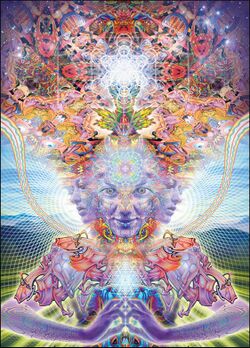
An autonomous entity is defined as the experience of perceived contact with beings which appear to be sentient and autonomous in their behaviour.[1][2][3][4][5][6][7][8] These entities can manifest within both external and internal hallucinations.[7]
Autonomous entities will frequently act as the inhabitants of a perceived independent reality.[6] Although many entities seem largely unaware of a person’s presence they are often precognizant of a person's appearance into their realm and usually choose to interact with them in various ways.
The behaviour of a typical entity can vary wildly and seems to depend heavily on one's current emotional state. For example, while many entities will act as loving beings, teachers, or healers in certain contexts they are equally capable of acting as indifferent, uncaring or even as malicious tormentors.[3][8]
Entities can take any form but subconscious archetypes are present and commonly include:[3][8]
Humans, shadow people, bodiless super intelligent humanoids, aliens, elves, animals, giant spheres, insectoids, beings of light, anthropomorphic beings, plants, conscious inanimate objects, fictional characters, cartoons, robotic machines, gods, demigods, goddesses, bio-mechanical intelligences, hooded figures, demons, indescribable monstrosities, spirits, angels, shamans, ghosts, souls, ancestors, fantastical or mythological beasts, glitch creatures and more.
This experience is often accompanied by other coinciding effects such as geometry,[4] internal hallucinations and delusions. It is most commonly induced under the influence of heavy dosages of hallucinogenic compounds, such as psychedelics, dissociatives, and deliriants. However, it can also occur under the influence of stimulant psychosis, sleep deprivation, and during dreams.
Debate over the existence of autonomous entities
The question of whether these autonomous entities are real or not has often been subject of discussion.
Assuming that our consciousness is formed by a complex and specific arrangement of neural networks, they can be said to be a consequence of the emergent properties of our brain. These perceived entities could be generated by transient changes in brain connectivity induced by certain substances.
For example, an increase in functional connectivity between or inside certain areas of the brain could cause a higher likelihood of the formation of various separated complex structures, which in some cases could be complex enough to be perceived as self-conscious or even have (or give the illusion to have) a higher intelligence than the perceiver.
This would mean that these entities, even though most of the times perceived as separated from our Self, are complex structures emerged by changes in our neural pathways. In a certain way they would be as real as we define ourselves to be (as a "conscious" being), because both our consciousness and the entities are formed by specific complex structures inside the brain. The same argument could be used in many other cases with other kinds of hallucinations and could even lead to the questioning of the definition of reality itself.
Another common hypothesis is that these entities already exist inside our subconscious and/or unconscious and are perceived by the conscious part of the brain due to an abnormal change in connectivity. The presence of certain entities within the unconscious has been widely discussed even in classic psychological literature. For example some of the archetypes hypothesized by Carl Gustav Jung were described as self-conscious entities.
These two hypothesis do not appear to be in conflict with each other, since the presence of innate entities within the psyche and the momentary or permanent formation of others do not exclude each other.
Personality types
There are several distinct personality types of autonomous entity which one may potentially encounter. They are often perceived to represent a particular subsection of a person’s own consciousness and can be identified primarily through their personality, but also their appearance. These individual types are broken down into three separate categories below:
- Representations of general concepts - This personality type can be described as a seemingly sentient representation of any known concept. This will usually adopt an appropriate personality and set of mannerisms to fit the chosen concept with an impressive degree of detail. For example, the specific concept could include other people that the person has met throughout their life, specific fictional characters or symbolic representations of concepts such as abstract ideas, emotions, or key parts of one's own personality.
- Representations of the self - This personality type can be described as a copy of one's own personality. It can take any visible form but when conversed with it clearly adopts an identical vocabulary and set of mannerisms to one's own consciousness.
- Representations of the subconscious - This personality type can be described as an entity which may take any visible form, but is also subjectively perceived to be an autonomous controller behind the continuous generation of the details of the person’s current hallucinations. They may also be felt to simultaneously control or manage one's current perspective, personality, and internally stored model of reality. When interacted with, this category of entity can often possess abilities which allow them to directly alter and manipulate one's current experiences. They commonly want to teach or guide the person and will operate under the assumption that they know what is best for them. However, it cannot be known whether this hallucination is genuinely a representation of the subconscious or is merely an approximation which behaves in a convincing manner.
Communication styles
Autonomous entities can communicate with a person via a combination of spoken word, “telepathy”, conceptual thoughts, mathematics, and geometry-based visual linguistics which generally consists of morphing colored structures of different textures that are innately understandable as representations of specific concepts. They will often convey insights regarding overcoming personal issues within a person’s life and will occasionally help clarify philosophical or spiritual ideas. However, more often than not entities are very likely to speak in a cryptic or nonsensical manner which seems to have no clear meaning behind it.
It is important to note that autonomous entities can never convey novel information to the person experiencing them. For example, they cannot provide insights about the external world which a person did not already know on some level. Instead, they can only provide alternative perspectives and help build upon existing ideas. This is presumably because autonomous entities do not have access to any knowledge which is not already contained within one's conscious or subconscious memories. May contain imprints of genetic memories, access to lifetimes that seem parallel or events that mirror one's connectivity moving past the default mode.
When communicated with through spoken word, the level of coherency in which these entities can communicate with is highly variable but can be broken down into four distinct levels. These are described and listed below:
- Silence - At the lowest level, the effect can be described as a complete unresponsiveness from the entity and a lack of speech despite their presence within the hallucination.
- Partially defined incoherent speech - At this level, the effect can be described as linguistic conversational responses and noises which almost sound like words but do not contain any real content or meaning beyond a vague sense of emotional intent.
- Fully defined incoherent speech - At this level, the effect can be described as audible linguistic conversational responses and noises which contain fully defined and understandable words, but often lack grammatical structure or an overall sense of general coherency.
- Partially defined coherent speech - At this level, the effect can be described as linguistic conversational responses which contain fully defined and understandable words with a partially defined grammatical structure and general coherency. It conveys its point on a level which is frequently coherent, but may not always be fully understandable and will sometimes descend into broken English or even gibberish.
- Fully defined coherent speech - At the highest level, the effect can be described as linguistic conversational responses which contain understandable words and fully defined grammatical sentence structures. It has an overall sense of general coherency which conveys its point in a level of detail that is genuinely on par with that of a person’s own intellect.
Image examples
| Caption | |
|---|---|
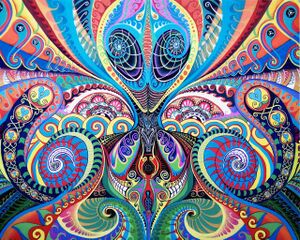 | Untitled by Anonymous |
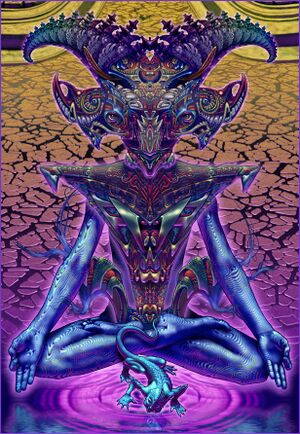 | Jerrestrial detail by Luke Brown |
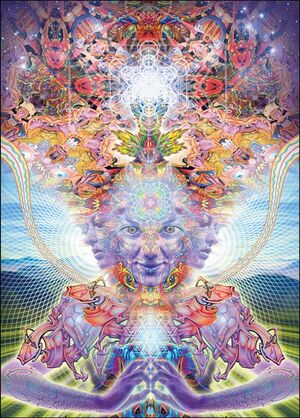 | Namaste (Trifoliata Mystica) by Luke Brown |
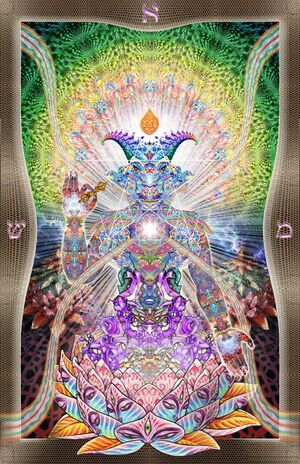 | Baphomet by Luke Brown |
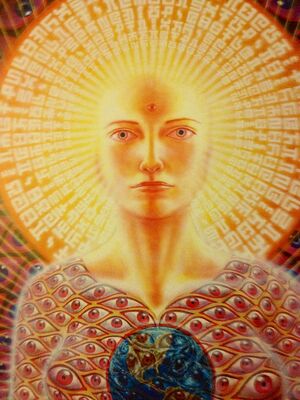 | Sophia by Alex Grey |
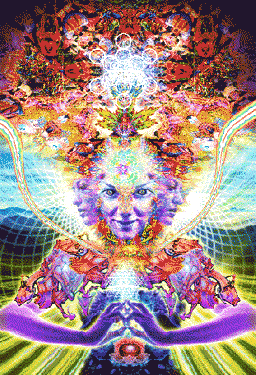 | Namaste 3D by Luke Brown |
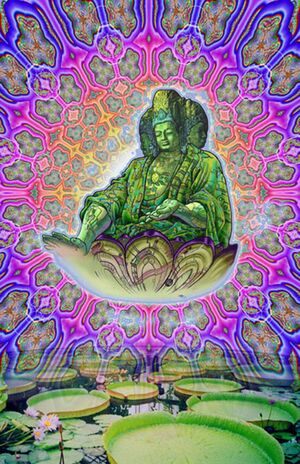 | Maitreya by Luke Brown |
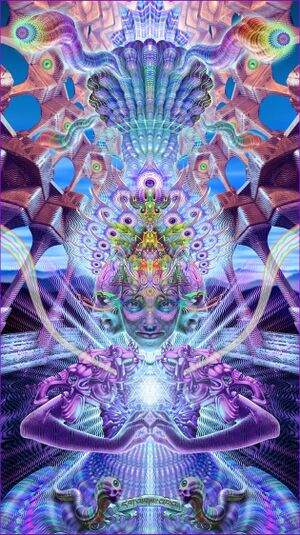 | Apotheosis by Luke Brown |
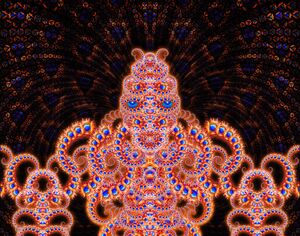 | Id-Aliunde by Beau Deeley |
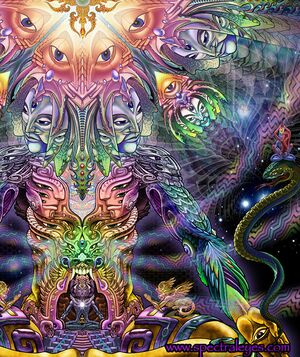 | Alpha Centauri by Luke Brown |
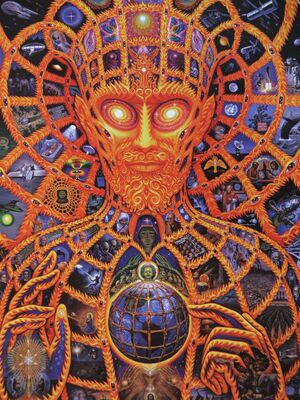 | Cosmic Christ by Alex Grey |
External hallucinations
An external hallucination is defined as the perception of a visual hallucination which displays itself seamlessly into the external environment as if it were actually happening.[9][10] This is in stark contrast to internal hallucinations, such as dreams, that occur exclusively within an imagined environment and can typically only be viewed with closed eyes.
This effect is capable of manifesting itself across the 4 different levels of intensity described below:
- Fleeting hallucinations - At the lowest level, external hallucinations generally consist of movement within the peripheral vision and ill-defined, fleeting hallucinations which disappear once a person double takes.
- Vaguely defined hallucinations - At this level, the hallucinations are visible within one's direct line of sight, but are not fully defined in their appearance. This means that, although visible, they do not look completely detailed and are often extremely blurry or semi-translucent with little, if any, colour.[10]
- Partially defined hallucinations - At this level, the hallucinations become distinct enough in their detail and vividness to extend beyond transparent, colourless, or blurry manifestations. However, they still remain unconvincing and do not quite live up to the detail of everyday life.
- Fully defined hallucinations - At this level, the hallucinations have become completely realistic and will rarely disappear simply because a person double takes. They are now capable of a completely convincing and photorealistic appearance and their behaviour becomes far more lifelike. Additionally, they may become numerous enough to fully engulf the entirety of the person's environment.[10]
Alongside a specific levelling system, there are also certain environmental factors that directly alter both the likelihood of external hallucinations manifesting themselves and the level of detail of which they are rendered with. For example, the more unfamiliar with the external environment a person is, the more likely it is that this effect will manifest itself. Cluttered areas tend to produce more external hallucinations and the amount of light within a room is inversely proportional to the intensity of them, with less light leading to significantly more hallucinations and more light leading to fewer, although more detailed, hallucinations.
The content within these external hallucinations can be further broken down into four distinct subcomponents. These are described and documented within their own dedicated articles, each of which are listed below:
- Autonomous entities
- Object activation
- Perspective hallucination
- Scenarios and plots
- Settings, sceneries, and landscapes
- Shadow people
It is worth noting that the content, style, and general behaviour of an external hallucination is often largely dependent on the emotional state of the person experiencing it. For example, a person who is emotionally stable and generally happy will usually be more prone to experiencing neutral, interesting, or positive hallucinations. In contrast, however, a person who is emotionally unstable and generally unhappy will usually be more prone to experiencing sinister, fear-inducing, and negative hallucinations.
External hallucinations are often accompanied by other coinciding effects such as delirium, internal hallucinations and delusions. They are most commonly induced under the influence of heavy dosages of deliriant compounds, such as DPH, datura, and benzydamine. However, they can also occur less commonly under the influence of psychedelics, dissociatives, stimulant psychosis, and sleep deprivation.
Internal hallucinations
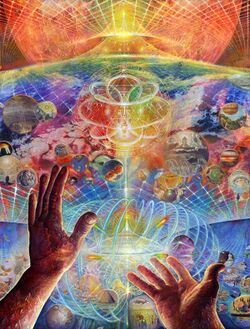
An internal hallucination is defined as the perception of a visual hallucination that exclusively occurs within an imagined environment which can typically only be viewed with closed eyes,[11][12] similar to those found within dreams.[13][14][15] This is in stark contrast to external hallucinations, which display themselves seamlessly into the external environment as if they were actually happening.
At lower levels, internal hallucinations begin with imagery on the back of a person's eyelids which do not take up the entirety of one's visual field and are distinct from their background. These can be described as spontaneous moving or still images of scenes, concepts, places, and anything one could imagine. The imagery is manifested in varying levels of realism, ranging from ill-defined and cartoon-like in nature to wholly realistic. They rarely hold their form for more than a few seconds before fading or shifting into another image. It is worth noting that this level of intensity occurs in a highly similar manner to that of hypnagogia, the state between sleep and wakefulness.
At higher levels, internal hallucinations become increasingly elaborate as they eventually become all-encompassing, fully-fledged 3D scenes which surround the person in a similar manner to that of dreams. This can create the feeling that one has "broken-through" into another reality. The things which occur within this perceived alternate reality can be anything but fall under common archetypes, such as contact with autonomous entities alongside a wide variety of imagined landscapes, and scenarios.
This effect is capable of manifesting itself across the 5 different levels of intensity described below:
- Enhancement of mental visualization - At the lowest level internal hallucinations can be defined as a distinct enhancement of mental visualisation that a person drifts into when daydreaming or using their imagination. It can be described as a short-term detachment from one's immediate surroundings, during which a person's contact with reality is blurred and partially substituted by an ill-defined fantasy. The details of this internal visualisation are slightly spontaneous or autonomous in nature but are mostly controlled by the content of one's current thought stream.
- Partially defined imagery - At this level, internal hallucinations consist of partially defined, blurred, and faded imagery within a person's visual field.
- Fully defined imagery - At this level, the vividness and intensity increases in a fashion which renders the imagery seen within one's visual field as fully defined and realistic in its appearance.
- Partially defined immersion - At this level, the vividness, scope, and intensity of the hallucinations become all-encompassing in a way which begins to display momentary flashes of scenes which surround the person in an immersive environment in a similar fashion to that of a vague dream. Although all-encompassing, they are often blurred or transparent in appearance, and a person's physical body still feels as if it is partially connected to the real world.
- Fully defined immersion - At the highest level, the internal hallucinations further increase to become all-encompassing in a manner which displays long-lasting scenes which surround the person with an explorable and fully immersive environment which is similar to that of a dream. This occurs in a fashion which is entirely realistic, detailed, and highly vivid in its appearance. It typically also occurs alongside relevant auditory and tactile hallucinations, as well as the sensation that a person has become completely disconnected from their physical body.
The content within these external hallucinations can be further broken down into four distinct subcomponents. These are described and documented within their own dedicated articles, each of which are listed below:
- Autonomous entities
- Object activation
- Perspective hallucination
- Scenarios and plots
- Settings, sceneries, and landscapes
- Shadow people
It is worth noting that the content, style, and general behaviour of an internal hallucination is often largely dependent on the emotional state of the person experiencing it. For example, a person who is emotionally stable and generally happy will usually be more prone to experiencing neutral, interesting, or positive hallucinations. In contrast, however, a person who is emotionally unstable and generally unhappy will usually be more prone to experiencing sinister, fear-inducing, and negative hallucinations.
Internal hallucinations are often accompanied by other coinciding effects such as geometry, external hallucinations and delusions. They are most commonly induced under the influence of heavy dosages of hallucinogenic compounds, such as psychedelics, dissociatives, and deliriants. However, they can also occur under the influence of stimulant psychosis, sleep deprivation, and during dreams.
Transition styles
Internal hallucinations typically last anywhere between 30 seconds and several minutes before the person slips back into reality or the presence of another hallucination. There are several different methods through which these hallucinations are transitioned between, these are described and documented below:
- Zooming - Images can switch between each other via the experience of one's vision zooming into or out of the current image to such an extent that it reveals an entirely new hallucination.
- Morphing - Images can switch between each other by transforming the details of their shape and structure to show an entirely new image. This can happen in a variety of different speeds and typically occurs in the style of a fluidlike motion.
- Sliding - Images can switch between each other by sliding in a specific direction which then reveals an entirely new image behind them.
- Fading - Images can change between each other by fading into nothingness before a completely new image fades back into view.
- Splitting - Images can switch between each other by splitting into two or more sections which drift away from each other to reveal an entirely new hallucination behind it.
- Tiling - Images can switch between each other by separating into geometric formations which then slide or fade away from each other to reveal an entirely new hallucination behind them.
Object activation
Object activation is defined as the experience of looking at an object and perceiving it to move, become alive, or become fully animated and autonomous of its own accord. For example, a door may open and close on its own or a cup on the table may start to slide or tilt over. The "activated object" usually moves in a familiar way that would happen in day to day life, implying that the person is experiencing a combination of both object alterations and external hallucinations being applied to their environment.
However, it is worth noting that certain activated objects may also perform actions which are completely unrealistic. For example, an item of furniture may appear to disassemble into many floating complex rotating sections before reassembling into its previous form. Stationary objects, such as rugs, may activate themselves and begin crawling on the floor and up onto other stationary pieces of furniture. These hallucinations usually only occur when one looks directly at an object for an extended period of time and are rare and extreme signs of an advanced hallucinatory state.
In rare cases, autonomous entities such as shadow people may aid in an object's activation. A shadow person or other autonomous entity may pick up, rearrange, or move a stationary object in front of the observer and act as a 'cause' of the object's activation.
Object activation is often accompanied by other coinciding effects such as delirium, psychosis, cognitive dysphoria, and delusions in a manner which can result in the hallucinations being perceived to have distinctly sinister and unsettling undertones. It is most commonly induced under the influence of heavy dosages of deliriant compounds, such as DPH, datura, and benzydamine. However, they can also occur to a lesser extent under the influence of psychedelics, dissociatives, stimulant psychosis, and sleep deprivation.
Perspective hallucinations
A perspective hallucination is defined as an alteration of the perspective through which a given internal or external hallucination is seen through.[16][9][17][18][19]
This effect is capable of manifesting itself across the four different perspectives described below:
- 1st person - The most common form of perspective can be described as the normal experience of perceiving a hallucination from the person's everyday self and body.
- 2nd person - This perspective can be described as the experience of perceiving a hallucination from the viewpoint of an external source of consciousness, such as another person, an animal, or an inanimate object.
- 3rd person - This perspective can be described as an out-of-body experience[16][9][17][18][19][20][21] where a person's viewpoint is floating above, below, behind, or in front of their physical body.
- 4th person - The least common form of perspective can be described as the experience of perceiving a hallucination from multiple or even seemingly infinite viewpoints and angles simultaneously.
Perspective hallucinations are often accompanied by other coinciding effects such as delirium, and memory suppression. They are most commonly induced under the influence of heavy dosages of hallucinogenic compounds, such as psychedelics, dissociatives, and deliriants.
Settings, sceneries, and landscapes
Settings, sceneries, and landscapes are defined as the perceived environment in which the plot of an internal or external hallucination occurs.[22] This effect is capable of manifesting in a seemingly infinite variety of potential places and settings.
When explored, the geography of these settings is capable of organizing itself as static and coherent. However, they may also manifest as a non-linear, nonsensical, and continuously changing layout which does not obey the laws of physics. The chosen locations, appearance, and style of these settings may be entirely new and previously unseen locations; however, there is a large influence towards replicating and combining real-life locations stored within a person's memories. There are some common themes and archetypes within this component which generally include:
Jungles, rainforests, deserts, ice-scapes, cities, natural environments, caves, space habitats, vast structures, civilizations, technological utopias, ancient ruins, machinescapes, historical settings, rooms and other indoor environments, real-life locations, incomprehensible geometric landscapes and more.
It is worth noting that the content, style, and general behaviour of a setting is often largely dependent on the emotional state of the person experiencing it. For example, a person who is emotionally stable and generally happy will usually be more prone to experiencing neutral, interesting, or positive settings. In contrast, however, a person who is emotionally unstable and generally unhappy will usually be more prone to experiencing sinister, fear-inducing, and negative settings.
Settings, sceneries, and landscapes are often accompanied by other coinciding effects such as autonomous entities and delusions. They are most commonly induced under the influence of heavy dosages of hallucinogenic compounds, such as psychedelics, dissociatives, and deliriants. However, they can also occur under the influence of stimulant psychosis and during dreams.
Shadow people
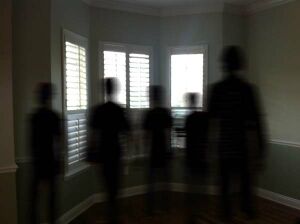
Shadow people are defined as the experience of perceiving patches of shadow in one's peripheral or direct line of sight that appear and behave as living, autonomous beings.[9][23][24] Due to the unique behavior of these hallucinations they can be considered as a distinct sub-type of autonomous entity.
Shadow people usually, but not always, begin to appear initially as fleeting images in a person's peripheral vision. However, at higher levels of intensity shadow people may begin to appear in full view in a manner which allows them to be directly looked at. At advanced mental states, it is even possible to look away from and look back at the shadow person without a change in the presence or appearance of the hallucination.
The bodies of these shadow people are usually perceived as being comprised of a type of blackness that has a sense of depth with few facial or bodily features. The blackness of their bodies often seem almost opaque, as if one is looking into a "black hole" in humanoid form. They may also appear in the shape of animals, uniform blobs, disembodied body parts, or a myriad of other indescribable shapes. They sometimes appear to have faces, eyes, or mouths and are able to move or change shape. The movement exhibited can be normal human movement or it can be faster, slower, or more choppy than a normal person's gait. It is also possible for multiple shadow people to occupy one's field of vision simultaneously while acting autonomously from one another and even interacting with each other.
It is worth noting that the style and general behaviour of a shadow person are often largely dependent on the emotional state of the person experiencing it. For example, a person who is emotionally stable and generally happy will usually be more prone to experiencing neutral, interesting, or friendly shadow people. In contrast, however, a person who is emotionally unstable and generally unhappy will usually be more prone to experiencing sinister and fear-inducing shadow people.
Shadow people are often accompanied by other coinciding effects such as delirium, paranoia, anxiety, and feelings of impending doom. They are most commonly induced under the influence of heavy dosages of deliriant compounds, such as DPH, datura, and benzydamine. However, they can also occur under the influence of stimulant psychosis, sleep deprivation, and during sleep paralysis.[25]
Multisensory aspects
Although it is uncommon and not an intrinsic part of this hallucinatory effect shadow people can sometimes be accompanied by other sensory components alongside of the person's visual perception of them. This is typically infrequent and usually only occurs during very intense states of sleep deprivation, delirium, or psychosis. For example, shadow people can potentially have an accompanying "voice", despite the lack of a visible mouth structure. This auditory communication follows an identical leveling system of progressively more detailed and coherent spoken word in the same manner as a generic autonomous entity. Shadow people may converse with the person experiencing them or they may converse amongst each other, sometimes talking about the person going through the experience.
Alongside of accompanying auditory hallucinations, shadow people may also present tactile and gustatory hallucinations. This is even rarer than their potential auditory effects and typically only occurs in particularly intense and advanced hallucinatory states. Their tactile effects can be indistinguishable from a real human touch and may vary in temperature. They can also even include physical actions such as pulling of clothing, hair, or the skin.
Transformations
Transformations are defined as the experience of a perceived visual metamorphosis that specific parts of one's external environment undergo as they shapeshift into other objects. For example, people who undergo this effect will often report seeing parts of their environment shifting into completely different things. These transformations have a huge variety of potential artistic styles and differing levels of detail, realism, and animation.
These hallucinations are progressive in nature, which means they form by arising from patterns or objects and then, over a period of seconds, the object smoothly drifts in a fluid-like motion into an entirely new form. This is significantly enhanced and fueled by the separate visual effect of pattern recognition enhancement. It causes vague stimuli and objects to transform into incredibly detailed versions of what they were already perceived as being.
At lower levels, the process of transformation can require some minimal amount of focus and concentration to sustain and will appear more often in the peripheral field of vision. Losing concentration for an instant can cause the image to fade away or shift into another image. Holding the eyes still will usually increase the intensity of the progressive transformation. However, at higher levels, this becomes completely unnecessary.
It is worth noting that the content, style, and general behaviour of a transformation is often largely dependent on the emotional state of the person experiencing it. For example, a person who is emotionally stable and generally happy will usually be more prone to experiencing neutral and interesting transformations. In contrast, however, a person who is emotionally unstable and generally unhappy will usually be more prone to experiencing sinister and fear-inducing transformations which have the potential to exacerbate even more the negative feelings.
Transformations are often accompanied by other coinciding effects such as drifting, pattern recognition enhancement and external hallucinations. They are most commonly induced under the influence of moderate dosages of psychedelic compounds, such as LSD, psilocybin, and mescaline. However, they can also occur under the influence of deliriants such as DPH, datura, and benzydamine.
Unspeakable horrors
Unspeakable horrors are defined as the experience of prolonged exposure to indescribable scenarios and hallucinatory content of a scary and disturbing nature which are often directly influenced by a person's fears. This can occur during high dose hallucinogenic experiences, particularly those in which the user is currently undergoing negative emotional stressors and personal problems of an introspective nature.
Although the content which comprises these states are generally ineffable and largely dependent upon the fears of those who experience them, certain themes and archetypes often manifest themselves. These are not limited to but may consist of:
- Autonomous entities of an intrinsically sinister and threatening nature - This can include demons, deformed monstrosities, hooded figures, mocking entities and otherwise normal human beings deformed by severe injury or illness.
- Geometry of an intrinsically sinister and threatening nature - The hallucinatory states listed above are commonly comprised of and embedded within standard hallucinogenic geometry. This often contains innately readable geometric representations of pure conceptual fear, horror, and suffering which can be felt through all of the senses as they are perceived.
- Machinescapes of an intrinsically sinister and threatening nature - This can be described as functionally identical to the experience of machinescapes. It differs in that its comprising parts often almost exclusively consist of indescribably complex interlocking, ever-shifting biomechanical gore, organs, disembowelments, and body parts.
- Scenarios and plots of an intrinsically sinister and threatening nature - This can include scenes of suffering directed towards oneself or other people such as being tortured, scenes in which one is being hunted as prey by "evil" creatures or forces and the direct experience of personal fears.
- Settings, sceneries, and landscapes of an intrinsically sinister and threatening nature - This can include the visitation of hellish landscapes, ancient monolithic Lovecraftian architecture, and ruined civilizations.
- Fearing for the fabric of one's sanity - This can be described as feeling that one's current perception is so horrific that they will surely be left permanently insane with severe psychological damage. The effect can leave people with an immediate sense that ordinary life is a thin shell over a comparatively horrifying reality which cannot be dismissed or escaped from. It is worth noting, however, that although stressful, this effect rarely actually leaves individuals with lasting psychological problems.
The experience of this component and how it is interpreted by those who undergo it seems to differ wildly between people. While most individuals can find this state to be traumatizing if unprepared, many people find that, although terrifying, it is potentially exhilarating and character building in equal measure. To ensure that one does not find themselves in this state unwittingly, heavy dosages of hallucinogens should be avoided without prior practice, and a person should always work their way up to the higher levels from lower dosages in small increments as they feel comfortable doing so.
Unspeakable horrors are often accompanied by other coinciding effects such as anxiety, psychosis, and memory suppression. They are most commonly induced under the influence of heavy dosages of psychedelic compounds, such as LSD, psilocybin, and 2C-P. They can also occur under the influence of deliriants such as DPH, datura, and benzydamine. It is also possible to experience unspeakable horrors while under the influence of dissociatives such as DXM and PCP, but particularly when combined with other psychedelic substances such as LSD or Deliriant substances such as Diphenhydramine.
Image examples
| Caption | |
|---|---|
 | Untitled by Zdzisław Beksiński |
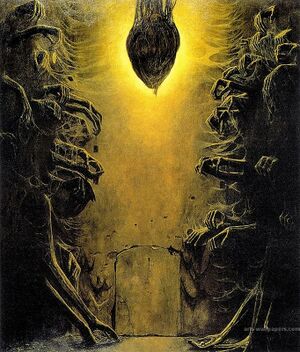 | Untitled by Zdzisław Beksiński |
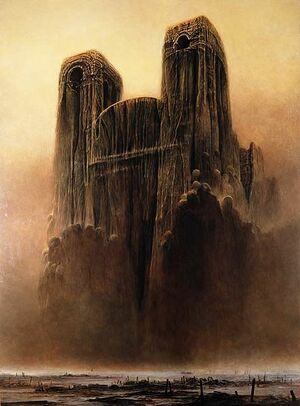 | Untitled by Zdzisław Beksiński |
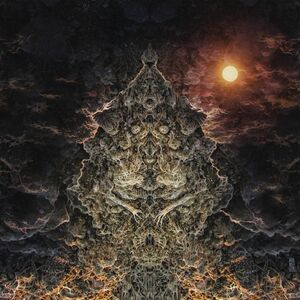 | Hatheg-Kla by MOracz |
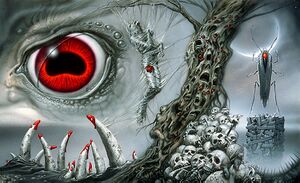 | Lovecraft's Nightmare by Michael Whelan |
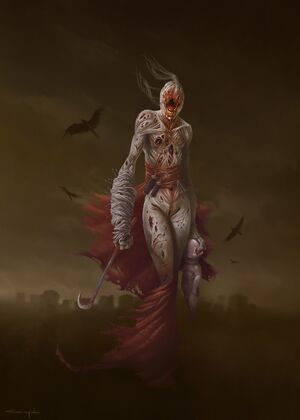 | The Nemesis by Adrian Grajdeanu |
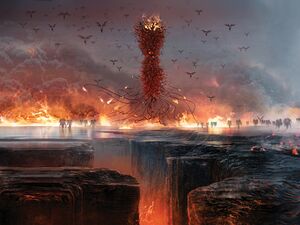 | Paradise lost clean by emaydani |
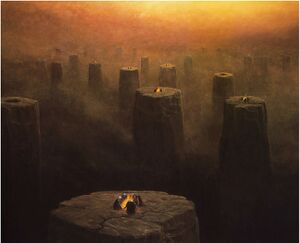 | Untitled by Zdzisław Beksiński |
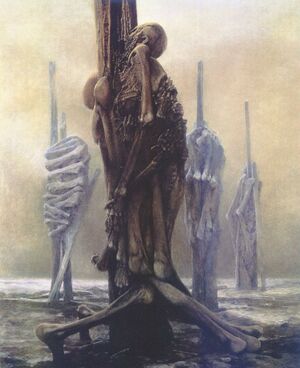 | Untitled by Zdzisław Beksiński |
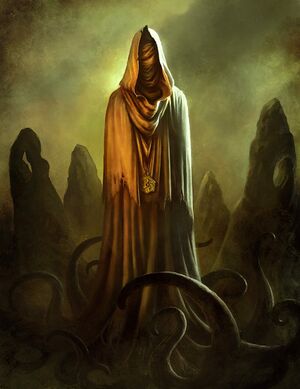 | King in Yellow by Borja Pintado |
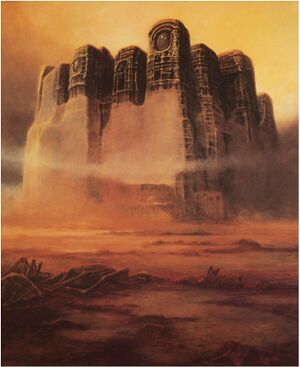 | Untitled by Zdzisław Beksiński |
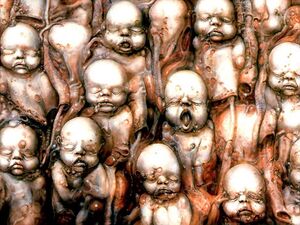 | Landschaft by H.R. Giger |
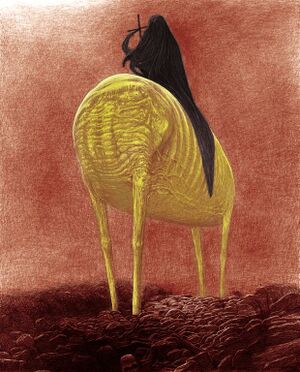 | Untitled by Zdzisław Beksiński |
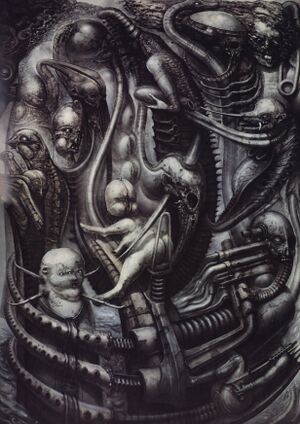 | National park by H.R. Giger |
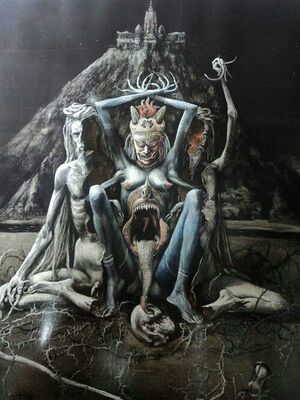 | A merging to the boundless by Star Gazer |
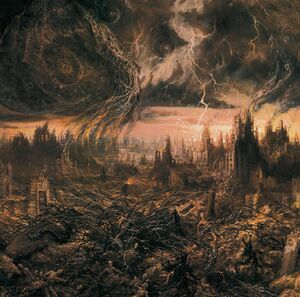 | Abrogation by Chaos inception |
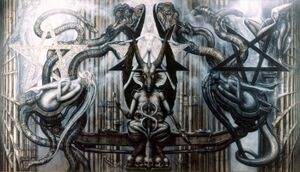 | The spell by H.R. Giger |
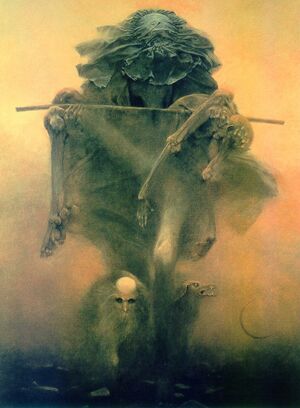 | Untitled by Zdzisław Beksiński |
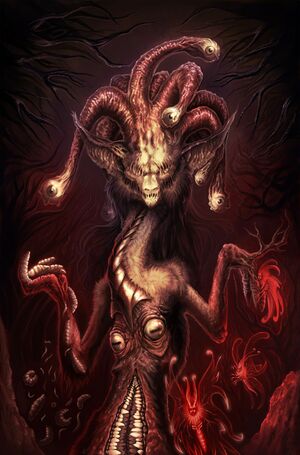 | Vigilant Jester by Tesper |
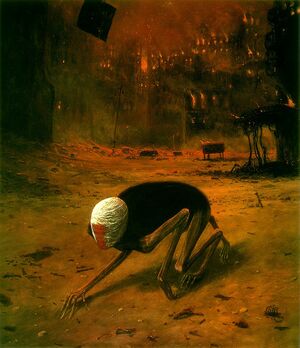 | Untitled by Zdzisław Beksiński |
 | Untitled by Zdzisław Beksiński |
 | Untitled by Zdzisław Beksiński |
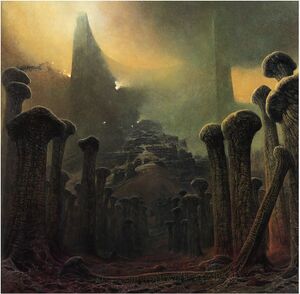 | Untitled by Zdzisław Beksiński |
See also
External links
References
- ↑ Hirshfeld-Flores, Alissa (2002). "DMT: The Spirit Molecule: A Doctor's Revolutionary Research Into the Biology of Near-Death and Mystical Experiences". American Journal of Psychiatry. 159 (8): 1448–1449. doi:10.1176/appi.ajp.159.8.1448. ISSN 0002-953X.
- ↑ Luke, D. (1 January 2012). "Psychoactive Substances and Paranormal Phenomena: A Comprehensive Review". International Journal of Transpersonal Studies. 31 (1): 97–156. doi:10.24972/ijts.2012.31.1.97.
- ↑ 3.0 3.1 3.2 Luke, D. (January 2011). "Discarnate entities and dimethyltryptamine (DMT): Psychopharmacology, phenomenology and ontology". Journal of the Society for Psychical Research. 75 (1): 26–42. ISSN 0037-9751.
- ↑ 4.0 4.1 Erowid DMT Vault : Apparent Communication with Discarnate Entities, by Peter Meyer
- ↑ Cott, C., Rock, A. "Phenomenology of N,N-Dimethyltryptamine use: a thematic analysis" (PDF). Journal of Scientific Exploration. 22: 359–370.
- ↑ 6.0 6.1 Metzner, Ralph (1998). "Hallucinogenic Drugs and Plants in Psychotherapy and Shamanism". Journal of Psychoactive Drugs. 30 (4): 333–341. doi:10.1080/02791072.1998.10399709. ISSN 0279-1072.
- ↑ 7.0 7.1 Shanon, B. (1 February 2002). "Ayahuasca visualizations a structural typology". Journal of Consciousness Studies. 9 (2): 3–30.
- ↑ 8.0 8.1 8.2 Strassman, R. (1 December 2000). DMT: The Spirit Molecule: A Doctor’s Revolutionary Research into the Biology of Near-Death and Mystical Experiences. Simon and Schuster. ISBN 9781594779732.
- ↑ 9.0 9.1 9.2 9.3 Obreshkova, D., Kandilarov, I., Angelova, V. T., Iliev, Y., Atanasov, P., & Fotev, P. S. (2017). PHARMACO-TOXICOLOGICAL ASPECTS AND ANALYSIS OF PHENYLALKYLAMINE AND INDOLYLALKYLAMINE HALLUCINOGENS (REVIEW). PHARMACIA, 64(1), 41-42. http://bsphs.org/wp-content/uploads/2017/04/Angelova.pdf
- ↑ 10.0 10.1 10.2 Gauntlett-Gilbert, Jeremy; Kuipers, Elizabeth (2003). "PHENOMENOLOGY OF VISUAL HALLUCINATIONS IN PSYCHIATRIC CONDITIONS". The Journal of Nervous and Mental Disease. 191 (3): 203–205. doi:10.1097/01.NMD.0000055084.01402.02. ISSN 0022-3018.
- ↑ Siegel, Ronald K. (1985). "LSD Hallucinations: From Ergot to Electric Kool-Aid". Journal of Psychoactive Drugs. 17 (4): 247–256. doi:10.1080/02791072.1985.10524329. ISSN 0279-1072.
- ↑ Kometer, M.; Schmidt, A.; Jancke, L.; Vollenweider, F. X. (2013). "Activation of Serotonin 2A Receptors Underlies the Psilocybin-Induced Effects on Oscillations, N170 Visual-Evoked Potentials, and Visual Hallucinations". Journal of Neuroscience. 33 (25): 10544–10551. doi:10.1523/JNEUROSCI.3007-12.2013. ISSN 0270-6474.
- ↑ Pekar, S. The connection between psilocybin and dreaming. https://www.lakeforest.edu/live/news/6657-the-connection-between-psilocybin-and-dreaming
- ↑ Kraehenmann, Rainer (2017). "Dreams and Psychedelics: Neurophenomenological Comparison and Therapeutic Implications". Current Neuropharmacology. 15 (7). doi:10.2174/1573413713666170619092629. ISSN 1570-159X.
- ↑ de Araujo, Draulio B.; Ribeiro, Sidarta; Cecchi, Guillermo A.; Carvalho, Fabiana M.; Sanchez, Tiago A.; Pinto, Joel P.; de Martinis, Bruno S.; Crippa, Jose A.; Hallak, Jaime E.C.; Santos, Antonio C. (2012). "Seeing with the eyes shut: Neural basis of enhanced imagery following ayahuasca ingestion". Human Brain Mapping. 33 (11): 2550–2560. doi:10.1002/hbm.21381. ISSN 1065-9471.
- ↑ 16.0 16.1 Dillon, P (2003). "Patterns of use and harms associated with non-medical ketamine use". Drug and Alcohol Dependence. 69 (1): 23–28. doi:10.1016/S0376-8716(02)00243-0. ISSN 0376-8716.
- ↑ 17.0 17.1 Jansen, K.L.R. (1990). "Neuroscience and the Near-Death Experience: Roles for the NMSA-PCP receptor, the sigma receptor and the endopsychosins". Medical Hypotheses. 31 (1): 25–29. doi:10.1016/0306-9877(90)90048-J. ISSN 0306-9877.
- ↑ 18.0 18.1 Rumpf K, Pedeck J, Teuteberg H. Munchhoff W. Nolte H. Dream-like experiences during brief anaesthesia with ketamine. thiopental and propanidid. p 161 in Ketamine (H Kreuscher. ed.) Springer-Verlag. Berlin, 1969.
- ↑ 19.0 19.1 Siegel R K. Phencyclidine and ketamine intoxication: a study of recreational users. p 119 in Phencyclidine Abuse: An Appraisal (R C Peterson. R C Stillman. eds.). National Institute on Drug Abuse Research Monograph 21. NIDA. Rockville. Maryland, 1978.
- ↑ Wilkins, Leanne K.; Girard, Todd A.; Cheyne, J. Allan (2011). "Ketamine as a primary predictor of out-of-body experiences associated with multiple substance use". Consciousness and Cognition. 20 (3): 943–950. doi:10.1016/j.concog.2011.01.005. ISSN 1053-8100.
- ↑ Przyby, A. (n.d.). A Philosophical Journey into the Heart of the Psychedelic Dream. Chicago, IL: University of Chicago. Retrieved February 24, 2018, from http://midwayreview.uchicago.edu/a/8/3/przybyl/przybyl.pdf
- ↑ Belser, Alexander B.; Agin-Liebes, Gabrielle; Swift, T. Cody; Terrana, Sara; Devenot, Neşe; Friedman, Harris L.; Guss, Jeffrey; Bossis, Anthony; Ross, Stephen (2017). "Patient Experiences of Psilocybin-Assisted Psychotherapy: An Interpretative Phenomenological Analysis". Journal of Humanistic Psychology. 57 (4): 354–388. doi:10.1177/0022167817706884. ISSN 0022-1678.
- ↑ Burke, Anna D.; Yaari, Roy; Tariot, Pierre N.; Dougherty, Jan; Fleisher, Adam S.; Brand, Helle (2012). "The Shadow People". The Primary Care Companion For CNS Disorders. doi:10.4088/PCC.12alz01398. ISSN 2155-7780.
- ↑ Vila-Rodriguez, Fidel; MacEwan, Gordon W.; Honer, William G. (2011). "Methamphetamine, Perceptual Disturbances, and the Peripheral Drift Illusion". The American Journal on Addictions. 20 (5): 490–490. doi:10.1111/j.1521-0391.2011.00161.x. ISSN 1055-0496.
- ↑ Adler, S. R. (2011). Sleep paralysis: night-mares, nocebos, and the mind-body connection. Studies in medical anthropology. Rutgers University Press. ISBN 9780813548852.